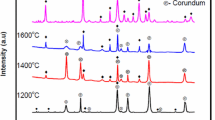Mullite-zircon ceramics obtained by plasma-arc sintering with an addition of Y2O3 in the range 1250 – 1450°C and with and without a clay addition are compared based on crystalline phase growth, apparent density, degree of sintering, Vickers hardness, ultimate compressive strength, and the strength of the linear correlation between the degree of sintering and the mechanical properties (Vickers hardness and ultimate compressive strength). The addition of clay to the initial component mixture that is to be sintered helps speed up mullitization, while the addition of Y2O3 increases the rate of formation of the cubic ZrO2 solid solution in the product within the temperature range 1250 – 1450°C. The clay addition produces specimens with the highest values for apparent density and degree of sintering, which also makes their values for Vickers hardness and ultimate compressive strength higher than the corresponding characteristics of the specimens obtained with only the Y2O3 addition. The linear correlation between degree of sintering and mechanical properties is strongest for the specimens obtained from sintered mixtures without an addition of clay.








Similar content being viewed by others
References
T. Ebadzadeh, “Formation of mullite from precursor powders: sintering, microstructure, and mechanical properties,” Mat. Sci. Eng A, 355(1/2), 56 – 61 (2003).
N. Behmanesh, S. Heshmati-Manesh, and A. Ataie, “Role of mechanical activation of precursors in solid state processing nanostructured mullite phase,” J. All. Comp., 450(1/2), 421 – 425 (2008).
N. C. Bijwas and S. P. Chaudhuri, “Comparative study of zirconia-mullite and alumina-zirconia composites,” Chem. Mat. Sci., 22(1), 37 – 41 (2003).
H. C. Park, “Preparation of zirconia-mullite composites by an infiltration route,” Ibid., 405(1/2), 2333 – 2338 (2005).
M. N. Rahaman, Ceramic Processing and Sintering, U. S., 2nd ed. (2003), pp. 818 – 819, 824 – 828, 830 – 837.
K. A. Khor, L. G. Yu, Y. Li, and Z. L. Dong, “Spark plasma reaction sintering of ZrO2-mullite composites from plasma spheroidized zircon/alumina powders,” Struct. Mat. Prop. Microst., 339(1/2), 286 – 296 (2003).
V. S. Gorshkov, Physical Chemistry of Silicates and Other High-Melting Compounds [in Russian], Vysshaya Shkola, Moscow (1988), pp. 344 – 346.
G. Lian, H. Jin-Sheng, M. Hiroki, and D. Sebastia, “Superfast densification of oxide ceramics by spark plasma sintering,” , J. Inorg. Mat., 13(1), 18 – 22 (1998).
E. Rocha-Rongel and H. Miyamoto, “Zirconia-mullite composites consolidated by spark plasma reaction sintering from zircon and alumina,” J. Am. Ceram. Soc., 88(5), 1150 – 1157 (2005).
S. Yugeswaran, V. Selvarajan, P. Dhanasekaran, and L. Lusvarghi, “Transferred arc plasma processing of mullite-zirconia composite from natural bauxite and zircon sand,” Vacuum, 83(2), 353 – 359 (2009).
http://www.Substech.com/spark plasma sintering/scheme.htm.
L. B. Kong, T. S. Zhang, J. Ma, and F. Boey, “Anisotropic grain growth of mullite in high-energy ball milling powders doped with transition metal oxides,” J. Eur. Ceram. Soc., 23(13), 2247 – 2256 (2003).
N. A. Toropov, V. P. Barzakovskii, and R. V. Lapin, Phase Diagrams of Silicate Systems: Reference Book [in Russian], Nauka, Moscow (1979), Vol. 1, pp. 437 – 439.
L. B. Kong, T. S. Zhang, F. Boey, and R. F. Zhang, “Mullite phase formation in oxide mixtures in the presence of Y2O3, La2O3, and CeO2,” J. All. Comp., 372(1/2), 290 – 299 (2004).
Author information
Authors and Affiliations
Corresponding author
Additional information
Translated from Novye Ogneupory, No. 4, pp. 33 – 38, April, 2014.
An erratum to this article is available at http://dx.doi.org/10.1007/s11148-017-0066-3.
An erratum to this article is available at http://dx.doi.org/10.1007/s11148-014-9704-1.
Rights and permissions
About this article
Cite this article
Khmelev, A.V. Production of a Mullite-Zirconia Ceramic by the Plasma-Spark Method. Refract Ind Ceram 55, 137–142 (2014). https://doi.org/10.1007/s11148-014-9676-1
Received:
Published:
Issue Date:
DOI: https://doi.org/10.1007/s11148-014-9676-1




